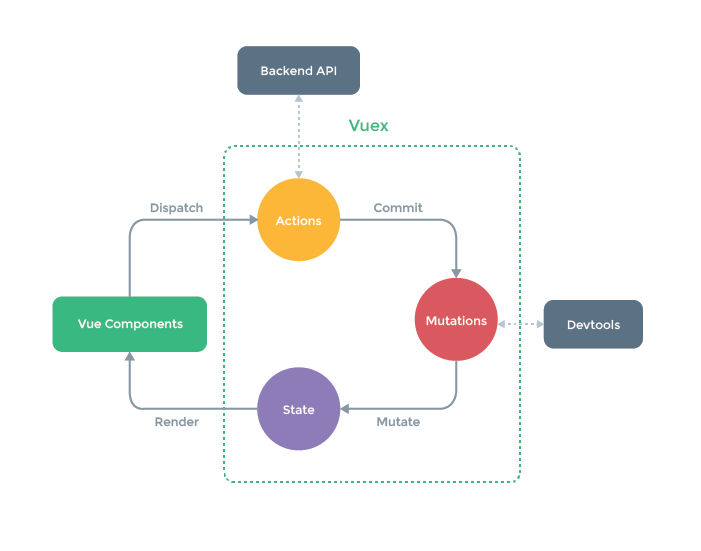1、Vuex.store 的基本使用
Vuex 是一个专为 Vue.js 应用程序开发的状态管理模式,它采用集中式存储管理应用的所有组件的状态,并以相应的规则保证状态以一种可预测的方式发生变化。
Vuex 使用单一状态树,即用一个对象包含全部的应用层级状态,这也意味着,每个应用将仅仅包含一个 store 实例。
每一个 Vuex 应用的核心就是 store(仓库)。Vuex 的状态存储是响应式的。当 Vue 组件从 store 中读取状态的时候,若 store 中的状态发生变化,那么相应的组件也会相应地得到高效更新。你不能直接改变 store 中的状态。改变 store 中的状态的唯一途径就是显式地提交 (commit) mutation。这样使得我们可以方便地跟踪每一个状态的变化,从而让我们更方便地使用一些工具比如 devtools 来调试我们的应用。

1.1、创建 store
- 首先安装 Vue、Vuex,在一个 JS 文件中创建一个 store
//store.js import Vue from 'vue' import Vuex from 'vuex' Vue.use(Vuex); const store = new Vuex.Store({ state: { count: 0 }, getters: { age () { return 232 } }, actions: {}, mutations: { increment(state,) { state.count++; } } }) export default store;
- 然后在 main.js 中引入 store
// main.js import Vue from 'vue' import App from './App' import router from './router' import store from './store/store.js' Vue.config.productionTip = false new Vue({ el: '#app', router, store, components: { App }, template: '<App/>' })
通过 store 选项能将状态从根组件“注入”到每一个子组件中(前面需先调用 Vue.use(Vuex))
在 main.js 文件中引入 store 后,该 store 实例会注入到根组件下的所有子组件中,其他组件就可以通过 this.$store 来访问这个 store 仓库了。
通过 this.$store.state 来访问数据、通过 this.$store.getters 来访问 getters 数据、通过 this.$store.commit('') 来调用 mutations 变更状态,通过调用 this.$store.dispatch('') 来触发 actions 调用 mutations。
2、Vuex.Store 的选项
2.1、state 选项
在组件中使用 store 中的 state,我们可以直接通过 this.$store.state 来使用,也可以通过将状态返回到组件中的计算属性中来使用,而且每当 $store.state.count 变化的时候, 都会重新求取计算属性。
2.1.1、mapState() 函数
我们可以使用 mapState 辅助函数来帮助我们将 state 返回到组件的计算属性中,减少我们的代码量。
mapState(nameSpace, Array | Object),mapState 辅助函数的第一个参数可选,表示的是一个命名空间字符串(跟模块化有关),第二个参数可以是数组或者对象。函数最终返回一个对象,我们可以使用对象展开运算符将此对象插入到计算属性中。
import { mapState } from 'vuex'
<script>
export default {
data () {
return {}
},
computed: {
name () { return 'wen' },
...mapState([
'count' // 组件中的 this.count 则是 this.$store.state.count
])
}
}
</script>
// 或者使用对象作为参数
computed: {
...mapState({
count: state => state.count,
// 传字符串参数 'count' 等同于 `state => state.count`
countAlias: 'count',
// 为了能够使用 `this` 获取局部状态,必须使用常规函数
countPlusLocalState (state) {
return state.count + this.localCount
}
})
}
2.2、getters 选项
store 中的 getters 就像计算属性一样,getters 的返回值会根据它的依赖被缓存起来,且只有当它的依赖值发生了改变才会被重新计算。
Getter 接受 state 作为其第一个参数,Getter 也可以接受其他 getter 作为第二个参数。
const store = new Vuex.Store({ state: { age: 23 }, getters: { //接收一个参数 myAge: state => { return state.age + 2 }, //接收两个参数 myAge2: (state, getters) => { return getters.myAge + 2; } } })
在组件中可以通过 this.$store.getters 来访问 getters 中的数据。
你也可以通过让 getter 返回一个函数,来实现给 getter 传参。注意,getter 在通过方法访问时,每次都会去进行调用,而不会缓存结果
getters: { // 返回一个函数 getTodoById: (state) => (id) => { return state.todos.find(todo => todo.id === id) } } //组件中访问时通过函数的形式访问,传入参数 this.$store.getters.getTodoById(2)
2.2.1、mapGetters() 函数
类似于 mapState 辅助函数一样,可以通过 mapGetters 辅助函数将 store 中的 getter 映射到局部计算属性
import { mapGetters } from 'vuex'
export default {
computed: {
// 数组作为参数
...mapGetters([
'doneTodosCount',
'anotherGetter',
// ...
])
}
}
//对象作为参数
...mapGetters({
// 把 `this.doneCount` 映射为`this.$store.getters.doneTodosCount`
doneCount: 'doneTodosCount'
})
2.3、mutations 选项
更改 Vuex 的 store 中的状态的唯一方法是提交 mutation。mutation 必须是同步函数,即里面不能有异步的操作。要想异步操作,可以使用 actions。
mutation 接受 state 作为第一个参数。
const store = new Vuex.Store({ state: { count: 1 }, mutations: { increment (state) { // 变更状态 state.count++ } } })
在组件中通过 this.$store.commit('increment') 的形式来调用 mutation
mutation 可以接收其他数据作为其他参数,即载荷(payload)。一般来说,其他的参数可以作为对象传过去,这样更加简洁一点。
mutations: { increment (state, n) { state.count += n } } //调用时 this.$store.commit('increment', 10) // payload 是对象 mutations: { increment (state, payload) { state.count += payload.amount } } //调用时 store.commit('increment', { amount: 10 }) //或者此时可以使用对象风格进行提交 store.commit({ type: 'increment', amount: 10 })
2.3.1、mutation 往 state 的某个对象中添加属性
当 mutation 需要在 state 中的某个对象添加新属性时,不能直接添加,应该使用 Vue.set 方法,比如 Vue.set(obj, 'newProp', 123) 。或者是新生成一个对象,用新对象替换旧对象:state.obj = { ...state.obj, newProp: 123 }
state: { man: { name: 'wen' } }, mutations: { //添加属性 addProp (state) { Vue.set(state.man, 'age', 22) // 或者:state.man = Object.assgin({}, state.man, {age: 22}) } }
2.3.2、mapMutations() 函数
mapMutations() 辅助函数将 store 中的 mutations 映射到局部方法中。
import { mapMutations } from 'vuex'
export default {
methods: {
...mapMutations([
'increment', // 将 `this.increment()` 映射为 `this.$store.commit('increment')`
// `mapMutations` 也支持载荷:
'incrementBy' // 将 `this.incrementBy(amount)` 映射为 `this.$store.commit('incrementBy', amount)`
]),
...mapMutations({
add: 'increment' // 将 `this.add()` 映射为 `this.$store.commit('increment')`
})
}
}
2.4、actions 选项
Action 用来提交 mutation,由 mutation 来变更状态,Action 可以包含任意异步操作。
Action 函数接受一个与 store 实例具有相同方法和属性的 context 对象,可以调用 context.commit 提交一个 mutation,或者通过 context.state 和 context.getters 来获取 state 和 getters。
const store = new Vuex.Store({ state: { count: 0 }, mutations: { increment (state) { state.count++ } }, actions: { increment (context) { context.commit('increment') } // 下面的写法更加简洁 increment ({ commit }) { commit('increment') } } })
在组件内可以通过 this.$store.dispatch('') 来触发 action。
actions 可以接收额外的参数,额外的参数写成一个对象更加简洁。
//接收额外的参数 actions: { increment ({ commit }, n) { if(n >= 0){ commit('increment') } } } //用对象作为额外的参数 actions: { increment ({ commit }, payload) { if(payload.n >= 0){ commit('increment') } } } //此时的调用方式 this.$store.dispatch('increment', { amount: 10 }) // 以对象形式分发 store.dispatch({ type: 'incrementAsync', amount: 10 })
2.4.1、mapActions() 函数
可以使用 mapActions 辅助函数将 actions 映射到组件的 methods 中。
import { mapActions } from 'vuex'
export default {
methods: {
...mapActions([
'increment', // 将 `this.increment()` 映射为 `this.$store.dispatch('increment')`
// `mapActions` 也支持载荷:
'incrementBy' // 将 `this.incrementBy(amount)` 映射为 `this.$store.dispatch('incrementBy', amount)`
]),
...mapActions({
add: 'increment' // 将 `this.add()` 映射为 `this.$store.dispatch('increment')`
})
}
}
2.4.2、组合使用多个 action
我们可以组合多个 action以处理比较复杂的异步流程。
如果 action 中有异步操作,我们可以使用 promise或者 async/await 函数来更改状态。
也可以通过返回一个 promise来组合使用action,store.dispatch 可以处理 action 处理函数返回的 Promise,并且 store.dispatch 仍旧返回 Promise,由此我们可以在 store.dispatch() 后面接着写我们需要的操作。
actions: { actionA ({ commit }) { return new Promise((resolve, reject) => { setTimeout(() => { commit('someMutation') resolve() }, 1000) }) } //在另一个 action 中可以操作前面的 action 函数 resolve 出的数据 actionB ({ dispatch, commit }) { return dispatch('actionA').then(() => { commit('someOtherMutation') }) } } //在组件中 store.dispatch('actionA').then(() => { })
在 action 中使用 async/await
// 下面假设 getData() 和 getOtherData() 返回的是 Promise actions: { async actionA ({ commit }) { commit('gotData', await getData()) }, async actionB ({ dispatch, commit }) { await dispatch('actionA') // 等待 actionA 完成 commit('gotOtherData', await getOtherData()) } }